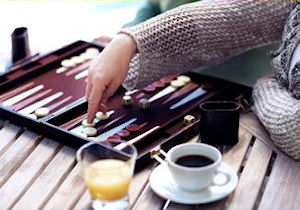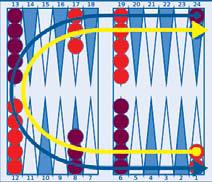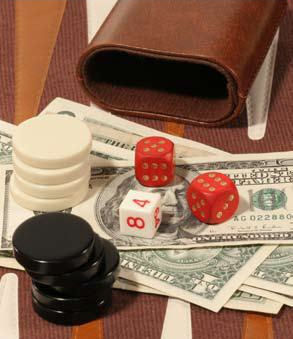This article first appeared in the Sep/Oct 2010 issue of World Gaming magazine.
In the last issue of World Gaming we talked about the history of this wonderful game. Today let’s talk about the basics of how backgammon is played. Backgammon is a very easy game to learn. These basic tips will have you playing and enjoying backgammon in no time.

Backgammon is played heads up (one on one), between two players who have 15 counters each (usually black counters vs red counters, or light counters vs dark counters). Counters are sometimes known as ‘stones’, ‘checkers’ or ‘men’.
The game is played on a backgammon set (or board) which has 24 long triangles (called points); split into four sections (also called boards) of six points each. Your very back point is known as your 24 point and your very front point (just before the finish line) is known as your 1 point. Points 1 to 6 are called your home (or inner) board and points 7 to 12 are called your outer board.
You win a game of backgammon by being the first player to take all your 15 counters off the board. Backgammon can be thought of a race between two ‘teams’, with the counters racing from the very back point (your 24 point, which is also your opponent’s 1 point), towards the very front point (your 1 point, which is your opponent’s 24 point). Your counters bear off the board completely (if you like, crossing the finish line), from a position somewhere in your home board (your last six points). A ‘team’ of 15 counters only completely crosses the finish line and completes the race when its last counter crosses the line. To win the game you must get your 15 counters off the board before your opponent gets his 15 counters off the board.
Both players move their counters in a horseshoe direction pushing against each other in the traffic flow, so this is an unusual race – you run in opposite directions! Another unusual thing about this race is that not all the counters start at the start line, only two of them do. Five of them are already half way home, three of them are two-thirds of the way home and five of them are three-quarters of the way home even before the starter’s gun is fired! Look at the diagram and you will see how to set up the board for the start of the game.

However, there’s one big difference between backgammon and a running race of 15 men, and that is that only one counter can move at a time.
You can play online or with a friend and a real board. Dice rolls occur alternately, and each player rolls two dice each time. For the first roll only, each player rolls one die with the player who rolled the highest die going first, using the two dice rolled as his first roll. If you both roll the same number on the first roll you both roll again until you roll a different number, therefore the first roll can never be a double (a double is when both dice show the same number).
When you roll your dice each individual die is evaluated separately. For example if you roll a 34 then you can move one of your counters 3 points and another one (or the same counter again) 4 points. Just be mindful though that these are two separate moves. A roll of 34 is a roll of 3 and 4, not a roll of 7. A roll of 62 is a roll of 6 and 2, not a roll of 8. You can move either die roll first, but you must use both if possible. Sometimes it’s only possible to move one of the two dice, and sometimes it’s not possible to move either! In the latter case, you forfeit your turn.
If your opponent has two or more counters on any given point then you cannot land your counters on that point. He owns that point, it’s his real estate. A good strategy in this game is to own as many points as possible close to each other so that it is hard for your opponent to move through that block of points. This is especially so if that block is in or near your home board. If there is a single counter on a point, that counter is called a ‘blot’. Blots are vulnerable. If an opposing counter lands on a point with a blot on it, that blot is captured and is sent all the way back to before the starting line. It sits off the board (it actually sits in the joint that separates the two halves of the board, called the ‘bar’, and while it sits there it is not in play). Before the player with the captured counter does anything he must get the captured counter back onto the board. He must roll both dice and place the captured counters back in his opponent’s home board on the point that matches his either of his dice. This means that this counter will still have to make the long journey from the 24 point all over again.

If your opponent has many of the points covered in his home board it can sometimes be hard to get a captured counter back into play. For example, if he has the 3 point and the 5 point covered, and you roll 53 trying to get your blot back in play, you can’t move. Your turn is forfeited and you have to wait until your next roll to try and get your captured counter back in the race. If you roll 52, you must put your blot on his 2 point (since his 5 point is covered) and now you can move your 5 anywhere on the board (including moving the counter that just re-entered the board). If you have any counters sitting up on the bar, you can’t move any of your other counters. There is no limit to how many counters can be captured – if you have a lot of your counters on the bar it can be frustrating.
Once you get all your 15 counters in your home board (the last six points), you are allowed to start taking them off the board. This is called bearing off. The final point at the very end of the board (next to the finish line) is considered the 1 point and at the other end of your home board is the 6 point. If you throw a 32 and you have a counter on the 2 and the 3 points then you can bear both those counters off. You can also move the counter on the 3 point to the 1 point with your roll of 2 if you so choose, but it’s generally a good idea to bear off if you can.
If you only have counters left on the larger numbered points and you throw small numbers you simply move the counters down your home board closer to the one point. If you roll a number higher than any of the counters you have left, you can bear off a counter on a lower numbered point. For example, let’s say you have counters on the 1, 2, 3 and 4 points, but none on the 5 or 6 points. You roll a 53. You can bear off a counter from the 3 point, and you can use your 5 to bear off a counter from the 4 point.
A good strategy here is to try your best to get an even spread of counters so you can take them off as quickly as possible when you start the bearing-off process. The other advantage to this strategy is you block points in your home board which will make it very hard for your opponent to get any captured counters back into the game, if you get lucky enough to capture his counters.
Another rule you must be aware of is that if you roll a double then it counts as double the double, that is four times! So let’s say you throw 55. You now make four (not two) moves of five points around the board. Whichever way you look at it doubles are especially useful at any stage of the game, except when you are trying to get a captured blot back in play and he has that point covered! The double double rule also counts at the end of the game when you are bearing off, so rolling double six always lets you bear four counters off. Double six is the magic dice roll of backgammon!
Of course you win the game when you bear off your last counter, and you opponent still has at least one counter on the board. If your opponent still has all 15 counters on the board, this is called a gammon and you win double. If you are lucky enough that your opponent still has at least one counter on the bar or in your home board, this is called a backgammon and you win triple.
Backgammon is a true betting game, there are lots of different ways to win and lose money on it. Sometimes play is for a certain amount of money per point, and gammons and backgammons also effect the payoff. Finally the doubling cube is a major part of the game specifically designed for betting. We’ll explain all these in our next article on the game, Betting in Backgammon.







